
Exhibit 99.01

NASDAQ: TNXP May 2015 © 2015 Tonix Pharmaceuticals Holding Corp.

2 Safe harbor statement Certain statements in this presentation regarding strategic plans, expectations and objectives for future operations or results are “forward - looking statements” as defined by the Private Securities Litigation Reform Act of 1995 . These statements may be identified by the use of forward - looking words such as “anticipate,” “believe,” “forecast,” “estimate” and “intend,” among others . These forward - looking statements are based on Tonix’s current expectations and actual results could differ materially . There are a number of factors that could cause actual events to differ materially from those indicated by such forward - looking statements . These factors include, but are not limited to, substantial competition ; our possible need for additional financing ; uncertainties of patent protection and litigation ; uncertainties of government or third party payor reimbursement ; limited research and development efforts and dependence upon third parties ; and risks related to failure to obtain U . S Food and Drug Administration clearances or approvals and noncompliance with its regulations . As with any pharmaceutical under development, there are significant risks in the development, regulatory approval and commercialization of new products . The forward - looking statements in this presentation are made as of the date of this presentation, even if subsequently made available by the Company on its website or otherwise . Tonix does not undertake an obligation to update or revise any forward - looking statement, except as required by law . Investors should read the risk factors set forth in the Annual Report on Form 10 - K for the year ended December 31 , 2014 , as filed with the Securities and Exchange Commission (the “SEC”) on February 27 , 2015 and future periodic reports filed with the SEC on or after the date hereof . All of the Company's forward - looking statements are expressly qualified by all such risk factors and other cautionary statements .

3 Financial summary NASDAQ: TNXP Cash reported at December 31 , 2014 $ 38.2 million Pro forma for n et proceeds from common stock offering in 1Q15 $ 67.2 million Shares outstanding (April 30, 2015) 16.1 million

4 Tonix is developing innovative medicines for large markets Common and chronic disorders of the central nervous system ( CNS) Next - generation medicines, novel treatment paradigms Late stage candidates with mitigated development risk C apitalized to achieve key readouts in all of our clinical - stage programs

5 Pipeline led by TNX - 102 SL for fibromyalgia (FM) Preclinical Phase 1 NDA Market Candidate Indication Phase 2 Phase 3 TNX - 102 SL Began Phase 2 trial - Jan ‘15 TNX - 102 SL Fibromyalgia Start Phase 3 trial - 2Q15 Start Phase 2 trial - 2Q15 TNX - 201 TNX - 102 SL (cyclobenzaprine HCl sublingual tablet) 2.8 mg and TNX - 201 ( dexisometheptene mucate ) are Investigational New Drugs and are not approved for any indication.

6 Fibromyalgia is a larg e pharmaceutical market * Lawrence et al, Arthritis Rheum 2008;58:26 - 35; Vincent et al, Arthritis Care Res 2013;65:786 - 792. Fibromyalgia is a chronic disorder characterized by: chronic widespread pain fatigue unrefreshed sleep diminished cognition Believed to result from amplified sensory and pain signaling Significant disability and impaired quality of life Estimated to affect ~10 million U.S. adults* and persists for years to decades FDA - approved drugs achieved 2014 sales of $1.2 billion

7 Receive long term benefit Respond, but intolerant of side effects Do not respond Market research by Frost & Sullivan (commissioned by Tonix ). * Robinson RL et al, Pain Medicine 2012;13:1366 - 76. 25% 35% 40% Fewer than half of those treated receive sustained benefit from the FDA - approved drugs Overall response rate is ~40% The majority discontinue therapy due to lack of a response or inability to tolerate Significant off - label use of prescription painkillers and sleep aids * i neffective for FM, and carry safety liabilities and addictive potential

8 Patients indicate that the symptom burden is high 0 1 2 3 4 5 6 7 8 Symptom Intensity During Past Week (Mean) Relief of many symptoms is important to patients Bennett et al, 2007; survey of 2,569 FM patients.

9 Tonix approaches the treatment of fibromyalgia by targeting sleep quality >90% of fibromyalgia patients complain of poor sleep quality* Sublingual tablet formulation of low - dose cyclobenzaprine (CBP) TNX - 102 SL is designed for chronic, bedtime administration 505(b)(2) regulatory pathway TNX - 102 SL demonstrated broad activity and was very well - tolerated in Phase 2b trial Observed statistically - significant improvements across key fibromyalgia symptoms Systemic tolerability similar to placebo Administration site reactions more common with TNX - 102 SL 2.8 mg daily dose confirmed for future development * Swick, Ther Adv Musculoskel Dis 2011;3:167 - 178. T NX - 102 SL (cyclobenzaprine HCl sublingual tablet) 2.8 mg is an Investigational New Drug and is not approved for any indication . Opportunity for a new fibromyalgia medicine with a unique profile

10 Phase 2b “BESTFIT” trial in fibromyalgia BESTFIT = BE dtime S ublingual T NX - 102 SL as F ibromyalgia I ntervention T herapy Randomized , double - blind, placebo - controlled trial 2010 American College of Rheumatology diagnostic criteria for fibromyalgia 205 participants were randomized 1:1 at 17 U.S. sites One sublingual tablet of TNX - 102 SL 2.8 mg or placebo daily at bedtime for twelve weeks Evaluated measures of pain, sleep quality, and other assessments of fibromyalgia symptoms First Patient – First Dose Sept 2013 Last Patient – Last Dose Aug 2014 TNX - 102 SL (cyclobenzaprine HCl sublingual tablet) 2.8 mg is an Investigational New Drug and is not approved for any indication.

11 TNX - 102 SL broadly improved fibromyalgia in the BESTFIT study Outcome Measure at Week 12 Declared Secondary Endpoints p value Daily Pain Diary, NRS Proportion Achieving 30% Improvement* 0.033 PROMIS Sleep Disturbance T - score Change 0.005 Patient Global Impression of Change Responder Analysis 0.025 FIQ - R Total Score Mean Change 0.014 NRS = Numeric Rating Scale for pain; PROMIS = Patient - Reported Outcomes Measurement Information System FIQ - R = Fibromyalgia Impact Questionnaire - Revised * FDA - accepted primary endpoint in the upcoming Phase 3 study BESTFIT pre - specified primary endpoint: change in mean pain score p=0.172 Data based on intent - to - treat analysis, N=205 (TNX - 102 SL N=103, placebo N=102) p < 0.05 a chieved statistical significance Source: Phase 2b BESTFIT study data TNX - 102 SL (cyclobenzaprine HCl sublingual tablet) 2.8 mg is an Investigational New Drug and is not approved for any indication.

12 TNX - 102 SL was very well - tolerated in the BESTFIT study No serious adverse events (SAE) reported with TNX - 102 SL Most frequent local adverse events were administration site reactions Previously reported in TNX - 102 SL Phase 1 studies; no detectable bias on efficacy results Transient tongue numbness (42% TNX - 102 SL vs. 1% placebo ) Abnormal taste (8% TNX - 102 SL vs. 0% placebo) Trial completion rates of 86% with TNX - 102 SL vs. 83% with placebo Systemic adverse events reported by at least 3.0% of the total study population TNX - 102 SL (N=103) Placebo (N=101) Total (N=204) Somnolence 1.9 6.9 4.4 Dry Mouth 3.9 4.0 3.9 Back Pain 4.9 3.0 3.9 Source: Phase 2b BESTFIT study data TNX - 102 SL (cyclobenzaprine HCl sublingual tablet) 2.8 mg is an Investigational New Drug and is not approved for any indication.

13 Phase 3 “AFFIRM” study of TNX - 102 SL in fibromyalgia Randomized, double - blind, placebo - controlled trial in f ibromyalgia N=500; 30 - 35 U.S. clinical sites Primary efficacy endpoint: Difference in 30 % responder analysis at 12 weeks between TNX - 102 SL 2.8 mg and placebo Placebo once - daily at bedtime 12 weeks TNX - 102 SL once - daily at bedtime N = 250 N = 250 2.8 mg open - label extension TNX - 102 SL (cyclobenzaprine HCl sublingual tablet) 2.8 mg is an Investigational New Drug and is not approved for any indication . Top line data expected 2H16

14 Phase 2 trial of TNX - 102 SL for post - traumatic stress disorder (PTSD) is recruiting Preclinical Phase 1 NDA Market Candidate Indication Phase 2 Phase 3 Post - Traumatic Stress Disorder TNX - 102 SL Began Phase 2 trial - Jan ‘15 TNX - 102 SL Start Phase 3 trial - 2Q15 Start Phase 2 trial 2Q15 TNX - 201 TNX - 102 SL (cyclobenzaprine HCl sublingual tablet) 2.8 mg and TNX - 201 ( dexisometheptene mucate ) are Investigational New Drugs and are not approved for any indication.

15 Post - traumatic stress disorder is a chronic, debilitating condition Experiencing any trauma can lead to PTSD High incidence among soldiers and veterans Associated with suicide and unpredictable, violent behaviors 8.5 million U.S. patients A pproximately half are receiving medical treatment * Limited benefit from the two FDA - approved drugs Low rates of response in general Lack of efficacy evidence in men or in military populations Both are antidepressants, require dose titration, and carry a suicide warning N o new treatment in >10 years PTSD: A significant and growing public health problem * Kessler et al, Arch Gen Psych 2005;62:617 - 627; Wang et al., Arch Gen Psych 2005;62:629 - 640 .

16 High prevalence of PTSD among combat veterans 1. Norris, PTSD Res Quar. 2013. 2. Gradus JL, National Center for PTSD. 3. Tanielan , Invisible wounds of war. 2005. 4. CBO Report 2012 . 19 - 31% Vietnam veterans 1 10% Gulf war veterans 2 10 - 21% Operation Enduring Freedom (Afghanistan) / Operation Iraqi Freedom veterans 3,4

17 Military PTSD Convoy attack on Route Appaloosa: “Ambush Alley”
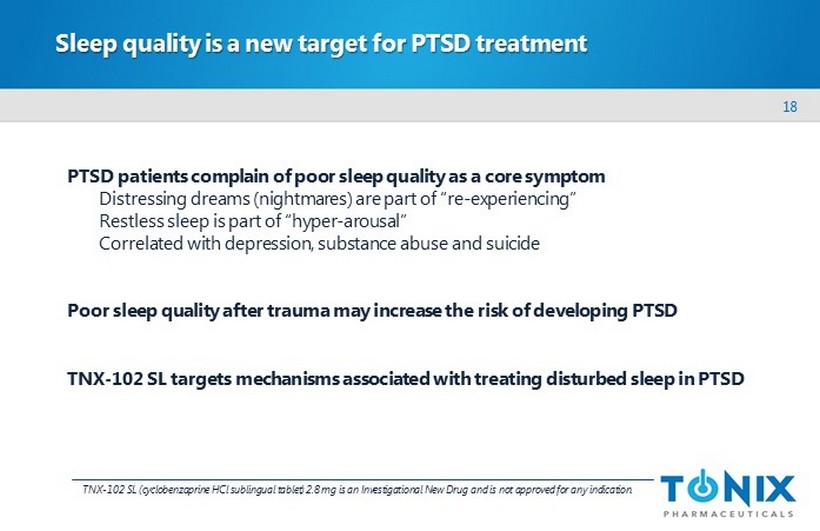
18 PTSD patients complain of poor sleep quality as a core symptom Distressing dreams (nightmares) are part of “re - experiencing” Restless sleep is part of “hyper - arousal” Correlated with depression, substance abuse and suicide Poor sleep quality after trauma may increase the risk of developing PTSD TNX - 102 SL targets mechanisms associated with treating disturbed sleep in PTSD Sleep quality is a new target for PTSD treatment TNX - 102 SL (cyclobenzaprine HCl sublingual tablet) 2.8 mg is an Investigational New Drug and is not approved for any indication.

19 Fibromyalgia program informs TNX - 102 SL development in PTSD 2.8 mg dose supported by BESTFIT study results Improvements observed in BESTFIT on several metrics that relate to PTSD core symptoms TNX - 102 SL (cyclobenzaprine HCl sublingual tablet) 2.8 mg is an Investigational New Drug and is not approved for any indication. Outcome Measure at Week 12 p value PROMIS Sleep Disturbance 0.005 FIQ - R Anxiety Item 0.015 FIQ - R Sensitivity Item 0.017

20 Phase 2 “ AtEase ” trial of TNX - 102 SL in PTSD – ongoing Randomized, double - blind, placebo - controlled trial in military - related PTSD N=220; approximately 25 U.S. clinical sites Primary efficacy endpoint: Difference in Clinician - Administered PTSD Scale (CAPS) score between TNX - 102 SL 2.8 mg and placebo at eight weeks TNX - 102 SL at bedtime once - daily Placebo at bedtime once - daily 12 weeks N = 88 TNX - 102 SL at bedtime once - daily N = 88 N = 44 2.8 mg 5.6 mg open - label extension TNX - 102 SL (cyclobenzaprine HCl sublingual tablet) 2.8 mg is an Investigational New Drug and is not approved for any indication . www.ateasestudy.com Top line data expected 1H16

21 TNX - 201 in development for episodic tension - type headache Preclinical Phase 1 NDA Market Candidate Indication Phase 2 Phase 3 TNX - 102 SL Began Phase 2 trial – Jan ‘15 TNX - 102 SL Start Phase 3 trial - 2Q15 Start Phase 2 trial - 2Q15 TNX - 201 Episodic Tension - Type Headache TNX - 102 SL (cyclobenzaprine HCl sublingual tablet) 2.8 mg and TNX - 201 ( dexisometheptene mucate ) are Investigational New Drugs and are not approved for any indication.

22 Episodic tension - type headache (ETTH) * Schwartz et al., JAMA 1998;279:381 - 383; Chowdhury, Ann Ind Acad Neurol 2012;15:83 - 88; Tonix analysis of public literature. ** Scher et al., Cephalalgia 2010;30:321 - 328; company analysis of public literature. 75 million adults in the U.S. experience frequent episodic tension - type headaches* Constant band of pressure on the back/sides of head; “squeezed in a vice” feeling “Frequent” = one to 15 headaches per month over a three - month period Approximately 60% receive treatment** All of the FDA - approved prescription medications contain barbiturates Over - the - counter medications are inadequate for many No new medications introduced for >40 years Class Product Company Regulatory Status Approval Year in ETTH Barbiturate Fiorinal ® Actavis Approved NDA 1976 Fioricet ® Actavis Approved NDA 1992 Barbiturate + Opiate Fiorinal with Codeine ® Actavis Approved NDA 1990

23 ETTH is the most common type of headache 60% 38% 13% 2% 0% 20% 40% 60% All Headaches ETTH Migraine Chronic One - Year Prevalence Rate for U.S. Adult Population (18 - 65) Adults (18 - 65)* * Estimated from 2013 U.S. Census Schwartz et al., JAMA 1998;279:381 - 383; Stovner et al, Cephalalgia 2007;27(3 ): 193 - 210. Frequent ETTH = one to 15 headaches per month over a three - month period • 63 % of all headaches • 80% of all non - migraine headaches • “non - migraine ” consists primarily of ETTH; >70% female ~119 M ~75 M ~26 M ~4.4 M 30% of U.S. adults experience frequent ETTH Episodic tension - type headaches account for approximately:
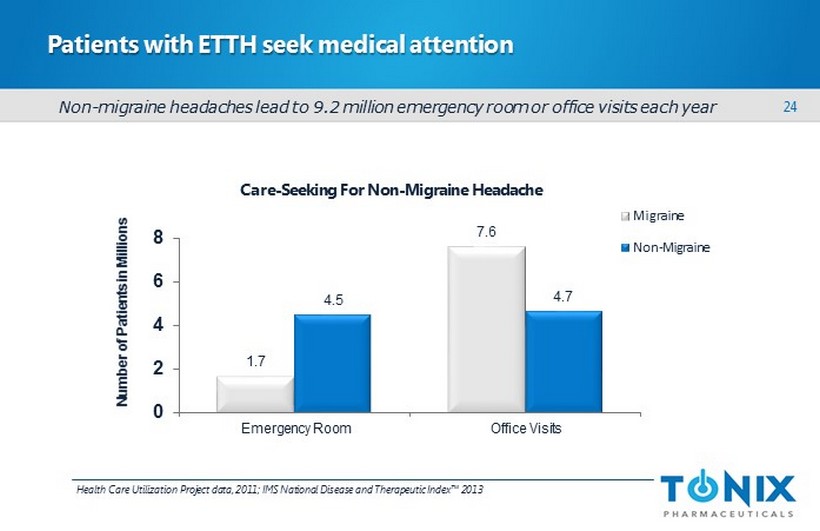
24 Patients with ETTH seek medical attention 1.7 7.6 4.5 4.7 0 2 4 6 8 Emergency Room Office Visits Number of Patients in Millions Care - Seeking For Non - Migraine Headache Migraine Non - Migraine Health Care Utilization Project data, 2011; IMS National Disease and Therapeutic Index™ 2013 Non - migraine headaches lead to 9.2 million emergency room or office visits each year
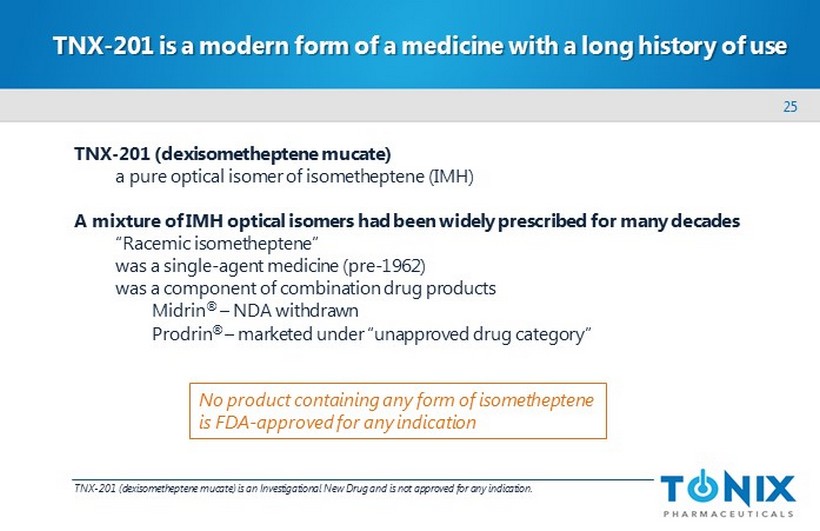
25 TNX - 201 is a modern form of a medicine with a long history of use TNX - 201 ( dexisometheptene mucate ) a pure optical isomer of isometheptene (IMH) A mixture of IMH optical isomers had been widely prescribed for many decades “ Racemic isometheptene ” was a single - agent medicine (pre - 1962) was a component of combination drug products Midrin ® – NDA withdrawn Prodrin ® – marketed under “unapproved drug category ” TNX - 201 ( dexisometheptene mucate ) is an Investigational New Drug and is not approved for any indication. No product containing any form of isometheptene is FDA - approved for any indication
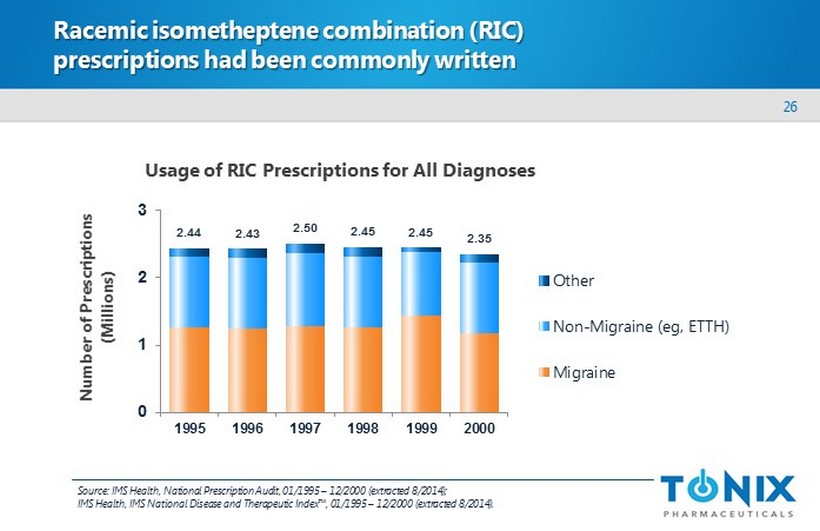
26 Racemic isometheptene combination ( RIC) prescriptions had been commonly written Usage of RIC Prescriptions for All Diagnoses 2.44 2.43 2.50 2.45 2.45 2.35 0 1 2 3 1995 1996 1997 1998 1999 2000 Number of Prescriptions (Millions) Other Non-Migraine (eg, ETTH) Migraine Source : IMS Health, National Prescription Audit, 01/1995 – 12/2000 (extracted 8/2014); IMS Health, IMS National Disease and Therapeutic Index™, 01/1995 – 12/2000 (extracted 8/2014).

27 Optical isomers of IMH have distinct pharmacological activities (R) isomer (S) isomer • Analgesic • Binds to imidazoline - 1 receptor • Inactive on adrenergic receptors • Sympathomimetic Previously marketed IMH drugs contained a mixture of two mirror - image isomers (racemic IMH) Tonix is developing a single IMH isomer for ETTH, supported by proprietary research x TNX - 201 TNX - 201 ( dexisometheptene mucate ) is an Investigational New Drug and is not approved for any indication.

28 TNX - 201 was well - tolerated in Phase 1 study Phase 1 study in healthy volunteers Single ascending dose study (N=45) – three cohorts of 15 subjects Randomized to TNX - 201, racemic IMH, or placebo (3:1:1 ratio, resp.) TNX - 201 ( dexisometheptene mucate ) is an Investigational New Drug and is not approved for any indication. TNX - 201 35 mg (N=9) TNX - 201 70 mg (N=9) TNX - 201 140 mg (N=9) Racemic IMH 70 mg (N=9) Placebo (N=9) Subjects reporting ≥1 adverse event, % 22 11 0 11 33 Adverse events reported by TNX - 201 subjects all rated as “mild” and most are not study drug - related No subject discontinued due to treatment - emergent adverse events Dose - related increase in TNX - 201 plasma levels ( C max , AUC) No evidence of isomer interconversion
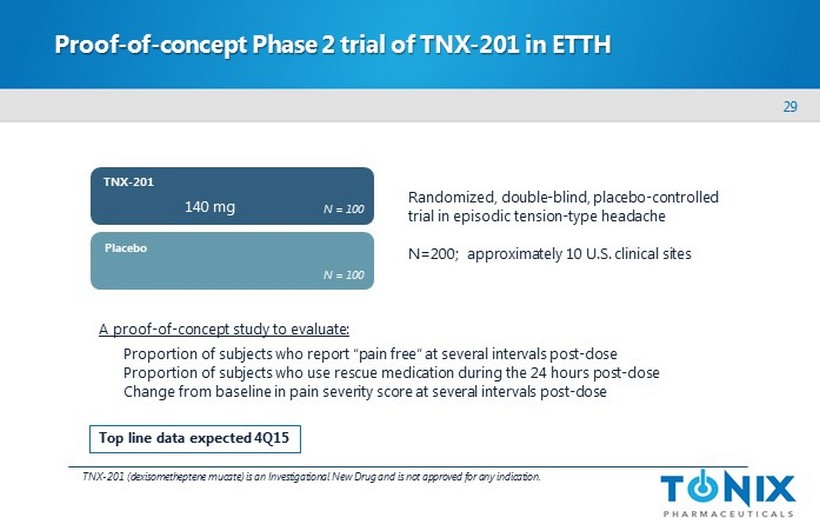
29 Proof - of - concept Phase 2 trial of TNX - 201 in ETTH TNX - 201 ( dexisometheptene mucate ) is an Investigational New Drug and is not approved for any indication. Randomized, double - blind, placebo - controlled trial in episodic tension - type headache N=200 ; approximately 10 U.S. clinical sites Placebo TNX - 201 N = 100 N = 100 140 mg A proof - of - concept study to evaluate: Proportion of subjects who report “pain free” at several intervals post - dose Proportion of subjects who use rescue medication during the 24 hours post - dose Change from baseline in pain severity score at several intervals post - dose Top line data expected 4Q15

30 TNX - 201 is active on the imidazoline - 1 receptor ( I 1 - R): a novel target for the treatment of pain Hot Plate Test Characteristics Transmembrane receptor Distinct from α 2 AR and MAO receptor subtypes No sequence similarity to GPCRs or ATP - sensitive K+ channels Shares similarities to ryanodine and cytokine receptors Mouse studies I 1 - R null mice show no difference in systolic blood pressure or heart rate compared to wild type I 1 - R null mice show a reduction in pain threshold compared to wild type in both the hot plate and tail flick tests Piletz JE et al, DNA Cell Biol 2000; 19:319 - 329. Zhang L et al, CNS Neurosci Ther 2013;19:978 - 981.
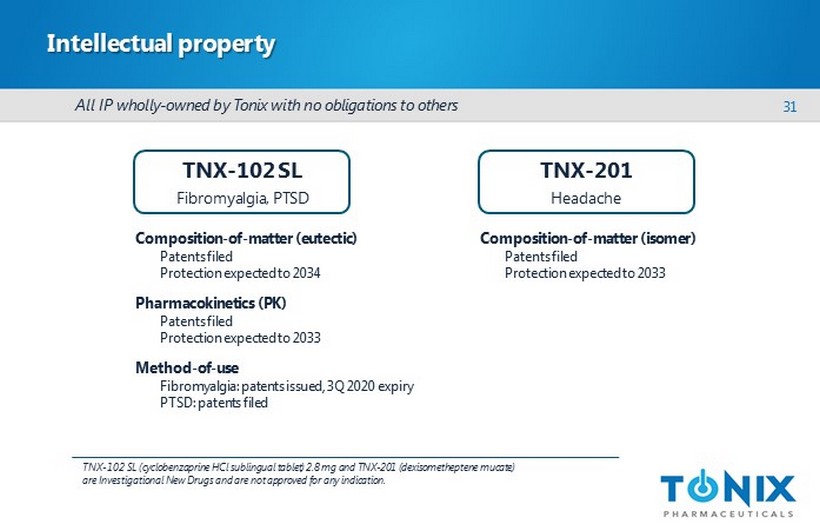
31 Intellectual property Composition - of - matter (eutectic) Patents filed Protection expected to 2034 Pharmacokinetics (PK) Patents filed Protection expected to 2033 Method - of - use Fibromyalgia: patents issued, 3Q 2020 expiry PTSD: patents filed TNX - 102 SL Fibromyalgia, PTSD TNX - 201 Headache Composition - of - matter (isomer) Patents filed Protection expected to 2033 All IP wholly - owned by Tonix with no obligations to others TNX - 102 SL (cyclobenzaprine HCl sublingual tablet) 2.8 mg and TNX - 201 ( dexisometheptene mucate ) are Investigational New Drugs and are not approved for any indication.

32 Management team Seth Lederman, MD President & CEO Leland Gershell, MD, PhD Chief Financial Officer Bruce Daugherty, PhD Chief Scientific Officer Ronald Notvest, PhD SVP, Commercial Planning & Development Gregory Sullivan, MD Chief Medical Officer
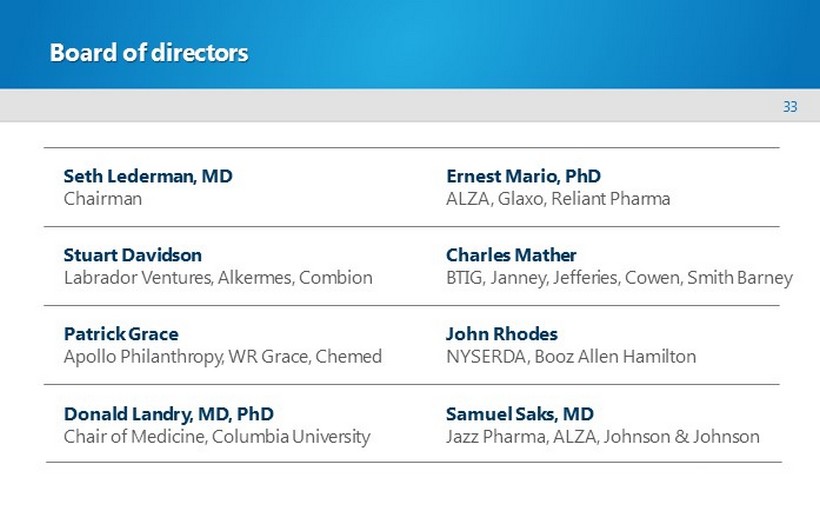
33 Board of directors Seth Lederman, MD Chairman Ernest Mario, PhD ALZA, Glaxo, Reliant Pharma John Rhodes NYSERDA, Booz Allen Hamilton Samuel Saks, MD Jazz Pharma, ALZA, Johnson & Johnson Charles Mather BTIG, Janney, Jefferies, Cowen, Smith Barney Stuart Davidson Labrador Ventures, Alkermes , Combion Patrick Grace Apollo Philanthropy, WR Grace, Chemed Donald Landry, MD, PhD Chair of Medicine, Columbia University
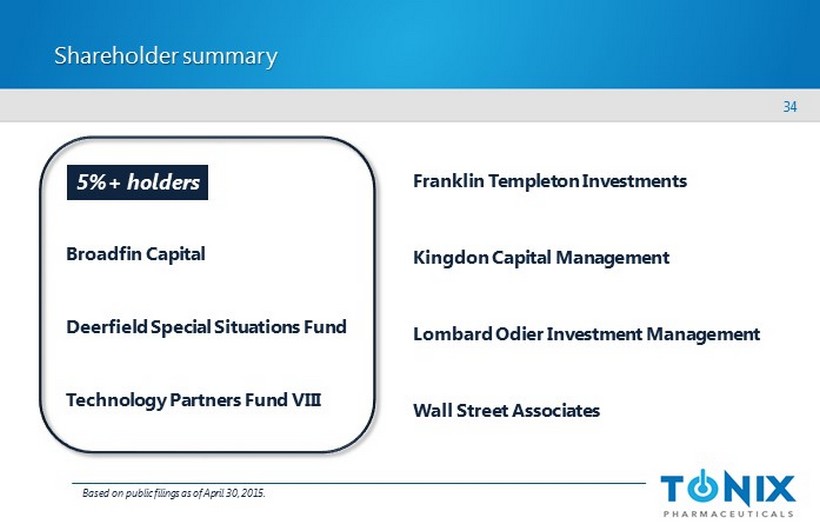
34 Shareholder summary Based on public filings as of April 30, 2015. Broadfin Capital Kingdon Capital Management Technology Partners Fund VIII Deerfield Special Situations Fund Franklin Templeton Investments Lombard Odier Investment Management Wall Street Associates 5%+ holders

35 TNX - 102 SL – Fibromyalgia □ September 2014 – Reported top line results from Phase 2b BESTFIT study □ January 2015 – Reported FDA acceptance of 30% responder analysis as Phase 3 primary endpoint □ 2Q 2015 – Begin Phase 3 AFFIRM study □ 2H 2016 – R eport top - line results from AFFIRM study TNX - 102 SL – Post - Traumatic Stress Disorder □ December 2014 – Began recruiting Phase 2 AtEase study in military - related PTSD □ 2Q 2015 – Provide update on enrollment and timing of results from AtEase □ 1H 2016 – Report top - line results from AtEase study TNX - 201 – Episodic Tension - Type Headache □ December 2014 – Completed Phase 1 clinical pharmacology study □ 2Q 2015 – Begin proof - of - concept Phase 2 study in ETTH □ 4Q 2015 – Report top - line results from proof - of - concept Phase 2 study x x x x Milestones – recent and upcoming TNX - 102 SL (cyclobenzaprine HCl sublingual tablet) 2.8 mg and TNX - 201 ( dexisometheptene mucate ) are Investigational New Drugs and are not approved for any indication.
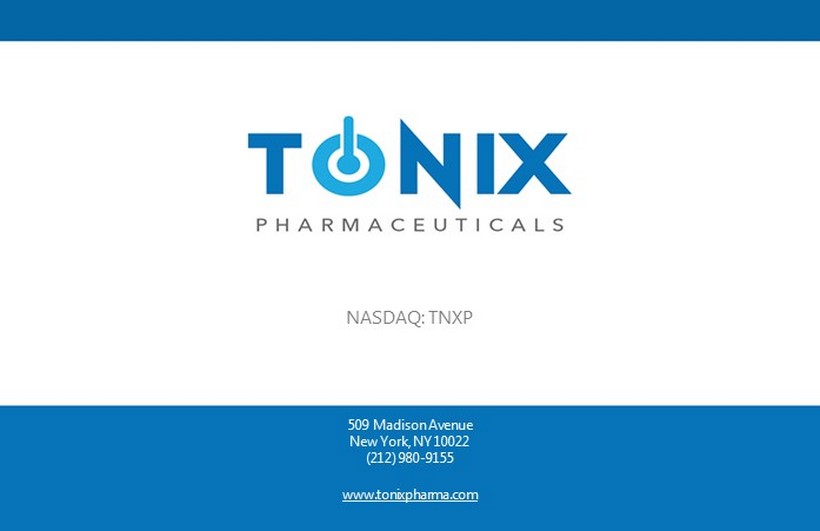
NASDAQ: TNXP 509 Madison Avenue New York, NY 10022 (212) 980 - 9155 www.tonixpharma.com